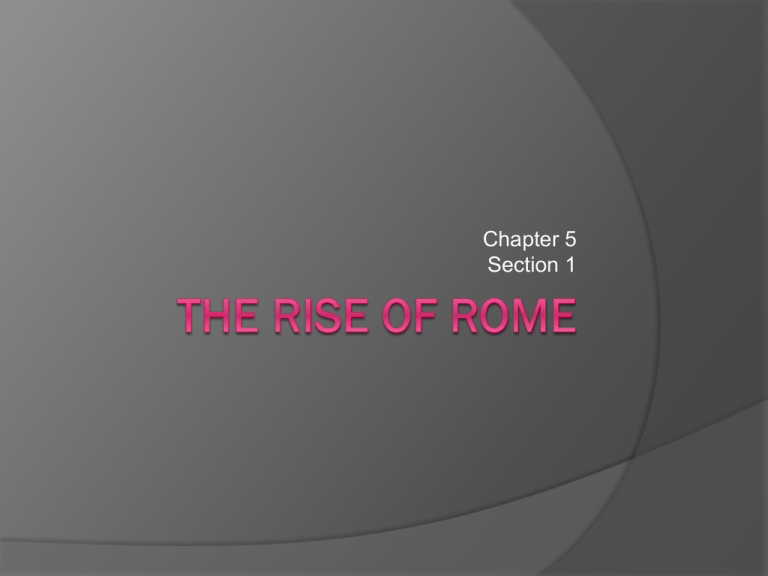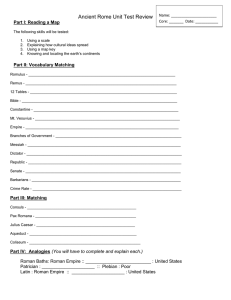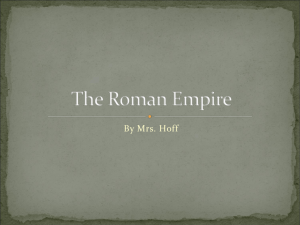The Rise of Rome
advertisement

Chapter 5 Section 1 The Land and Peoples of Italy Italy is a peninsula extending about 750 miles from north to south The Apennine fairly mountain range large fertile plains ideal for farming Greek Influence Arrived in Italy in large numbers during their colonization period Cultivated olives and grapes Passed on their alphabet Gave Romans artistic and cultural model through their developed art styles Etruscan Influence Etruscans – people located north of Rome in Etruria Greatly influenced early development of Rome Toga Army organization Building projects Government In 509 BCE, the Romans overthrew the last Etruscan king and established a Republic – a form of government in which the leader is not a monarch and certain citizens have the right to vote Roman Confederation created to rule Italy Full Roman citizenship to all peoples War and Conquest Rome was surrounded by enemies at the beginning of the Republic Engaged in almost continuous warfare over 200 years Conquered people remained free but contributed to new government Reasons for Success 1. The Romans were great diplomats a person who is tactful and skillful in managing delicate situations, people, etc. Extended Roman citizenship 2. The Romans excelled in military matters Early Rome was divided into 2 groups: Patricians ○ Great landowners / ruling class ○ Could be elected to gov’t positions Plebeians ○ Larger of the two groups, included craftspeople and small farmers Unbalanced Power The CEO of the Roman Republic were the consuls and praetors: Two consuls ran the gov’t and led the army The praetor was in charge of civil law The Roman Senate Held an important position in the Republic A select group of 300 patricians who served for life Very influential advice that had the force of law The Struggle of the Orders Often conflict between patricians and plebeians By 287 BCE, all male Roman citizens were supposedly equal under the law In reality, wealthy patrician and plebeian families formed a new senatorial ruling class that came to dominate the political offices Roman Law Rome’s chief gifts to the Mediterranean world was the Twelve Tables (adopted in 450 BCE) This helped the Romans developed a more sophisticated system of civil law Some of these standards are still recognized today CARTHAGE After their conquest of Italy, the Romans found themselves face to face with Carthage , a strong Mediterranean power with an enormous trading empire just off the coast of North Africa Largest richest state In 264 BCE, struggled with Rome for control of the Med First Punic War Rome’s first war with Carthage began in 264 BC and is known as the First Punic War This was fought over control of Sicily After a long struggle, a Roman fleet defeated the Carthaginian navy off the coast of Sicily and the war came to an end. In 241 BCE, Carthage gave up all rights to Sicily and paid a fine to the Romans Carthage vowed revenge In response, Hannibal, the greatest of the Carthaginian generals, struck back beginning the Second Punic War The Second Punic War Lasted from 218-201 BCE Hannibal decided to bring the war to Italy He entered Spain, moved east, and crossed the Alps with an army of 30-40 thousand men and 6,000 horses and elephants Rome decided to invade Carthage rather than fight Hannibal in Italy This forced Carthage to recall Hannibal In 202 BCE the Romans crushed Hannibal’s forces Carthage lost Spain, which became a Roman province Rome became the dominant power in the western Med. Carthage was destroyed in 146 BCE Carthage became a Roman province called Africa. Chapter 5 Section 2 The Senate controlled both foreign and domestic policy, and financial affairs The Senate and political offices were increasingly controlled by a small circle of wealthy and powerful families Many small farmers drifted to cities like Rome and formed a large class of landless poor General Marius recruited his armies in a new way ◦ Recruited urban poor and homeless by promising them land All volunteers swore and oath to the General Originally the Roman army had been made up of small farmers who were landholders To get laws passed for land for Veterans, Generals got involved politics Marius created a new system of military recruitment that placed much power in the hands of the generals For the next 50 years (82-31 BCE) Roman history was characterized by civil wars Three men emerged as victors: ◦ Crassus Known as the richest man in Rome ◦ Pompey Military hero ◦ Julius Caesar Held a military command in Spain The combined wealth and power of these men was enormous and enabled them to dominate the political scene In 60 BCE, Caesar joined w/ Crassus and Pompey to form the First Triumvirate ◦ A triumvirate is a gov’t by three people with equal power Pompey was given power over Spain Crassus over Syria Caesar in Gaul (Modern France) When Crassus was killed in battle in 53 BCE, leading senators decided that Pompey should be the only ruler They voted Caesar to lay down his command ◦ Caesar refused Caesar marched on Rome, defeated Pompey’s forces, and was left in complete control of the gov’t Caesar was officially made dictator in 47 BCE ◦ A dictator is an absolute ruler Caesar gave land to the poor and increased the Senate to 900 members ◦ This in turn weakened the power of the Senate ◦ In 44 BCE, a group of leading senators assassinated him A new struggle for power followed Caesar’s death 3 men joined forces and formed the Second Triumvirate: ◦ Octavian Caesar’s grand-nephew ◦ Antony Caesar’s ally ◦ Lepidus Caesar’s commander of cavalry Octavian and Antony soon came into conflict At the Battle of Actium in 31 BCE, Octavian’s forces smashed the army and navy of Antony ◦ Antony and Cleopatra Story Octavian, at the age of 32, stood supreme over the Roman world The wars had ended and so had the republic This period (31 BCE- 14 AD) became known as the Age of Augustus Octavian became the first Roman emperor in 27 BCE The Senate awarded him the title Augustus – ”the revered one” Name Change: ◦ Octavian = Augustus Augustus control of the army was the chief source of his power The Senate gave him the title of imperator – commander and chief ◦ Imperator gave us our word emperor Lasted from 14-180 AD Augustus’s new political system allowed the emperor to select his successor from his natural or adopted family The first 4 successors came from his family As the emperors grew more powerful, they became more corrupt ◦ EX: Nero – had people killed if he wanted them out of the way. Eventually the legions revolted and he chose to commit suicide. Under the 5 good emperors, the powers of the emperor cont’d to expand at the expense of the Senate They also created new programs to help the people The good emperors were praised for their building programs throughout the provinces of Rome ◦ Aqueducts, bridges, roads, and harbor facilities Rome expanded further during the period of the Early Empire Soon the emperors realized that the empire was too large to be governed easily At its height, the empire covered 3.5 million square miles and had a pop of over 50 million The privileges of Roman citizenship were granted to many people throughout the empire Cities were important in the Spread of Roman culture, law, and the Latin language Local city officials acted as Roman agents, performing gov’t duties….esp taxation Latin was the language of the western part of the empire --- Greek the east These cultures mixed freely and the result = Greco-Roman civilization The Early Empire was a period of peace which lead to high levels of trade Despite the active trade and commerce, farming remained the chief occupation Culture and Society in the Roman World Chapter 5, section 3 The Romans excelled in architecture Romans still used columns and rectangular buildings but they also developed the arch, vault, and dome Use concrete on a massive scale Network of 50,000 miles of roads throughout the empire THE ROMAN FAMILY At the heart of the Roman social structure stood the family Headed by the paterfamilias – the dominant male All Roman upper-class children were expected to learn to read Roman boys learned reading and writing, moral principles and family values, law, and physical training to prepare them to be soldiers Changing Roles By the 2nd century CE, important changes were occurring in the Roman family ◦ Women were no longer required to have guardians Upper-class women had considerable freedom and were appreciated as enjoyable company and at the center of household social life Slavery Slavery was common throughout the ancient world, but no people had more slaves or relied on their labor more than the Romans The slaves were most likely from Italy and were regarded as part of the family household Slaves built roads and public buildings, and farmed the large estates of the wealthy Some slaves revolted against their owners and even murdered them The most famous slave revolt in Italy occurred in 73 BCE Led by the gladiator, Spartacus, the revolt broke out in S. Italy and involved 70,000 slaves Spartacus managed to defeat several Roman armies before being trapped and killed in 71 BCE 6,000 followers of Spartacus were crucified Gladiator The most famous of all the public spectacles were the gladiatorial shows These events were an important part of society and were free to the public Games were held from dawn to dusk Most gladiators were slaves or condemned criminals who had been trained for combat in special gladiatorial schools Sometimes, criminals of all ages and both sexes were sent to the arena w/o weapons to face death from wild animals ◦ Numerous kinds of animal contests were held as well ◦ 5,000 beasts were killed in one day when the Emperor Titus inaugurated the Coliseum in 80 CE Bloody spectacles were indeed popular w/ the Roman people The gladiatorial games and public entertainment fulfilled a political need The games served to keep the minds of the idle masses off any political unrest. Chapter 5, section 5 After the death of Marcus Aurelius, the last of the 5 good emperors, Rome fell back into civil war A military gov’t under the Severan rulers restored order After this short dynasty Rome fell back into civil war For nearly 50 years, 235-284, the Roman throne was occupied by whoever had military strength to seize it In this period, there were 22 emperors, 20 of which experienced a violent death At the same time, the empire was troubled by a series of invasions From the east: Sassanid Persians From the North: Germanic tribes Invasions, civil wars, and plague came close to causing an economic collapse of the Roman Empire There was a noticeable decline in trade and small industry A labor shortage created by plague (an epidemic disease) affected both military recruitment and the economy Farm production declined The Roman Empire gained new lease on life through the efforts of two emperors, Diocletian and Constantine The empire was changed into a new state: The Late Roman Empire: New gov’t structure Rigid economic and social system New state religion: Christianity Diocletian (r. 284-305), feared the empire was too large for a single ruler and split the empire into 4 units Maintained a higher power thus making him the ultimate authority Constantine (r. 306-337) cont’d Diocletian’s policies Both rulers significantly strengthened and enlarge the admin bureaucracies of the Roman Empire and increased the size of the army The reformations of these two rulers enlarged both the army and civil service institutions of Rome This in turn drained most of the public funds More money was needed but the population wasn’t growing ▪ This means the tax base could not be increased To fight inflation – a rapid increase in prices – Diocletian issued a price edict in 301 that set wage and price control Despite heavy penalty, this failed to work When Constantine began his reign, he was the sole ruler of the entire Roman Empire He built a new capital in the east, Byzantium The city eventually became known as Constantinople and was considered the “New Rome” Constantine split the empire into Western and Eastern Empires Constantinople would became the center of the Eastern Roman Empire and one of the great cities of the world The capital of the Western Roman Empire remained in Rome Constantinople remained the capital of the Eastern Roman Empire The Western empire came under increasing pressure from the invading Germanic tribes The Huns who came from Asia, moved into Eastern Europe causing native German Visigoths to move south and west and into Roman territory Initially they settled but soon revolted against Roman rule In 410, the Visigoths sacked Rome Another group, Vandals, poured into Roman territory and crossed into Italy from Northern Africa In 455 they too sacked Rome In 476, the western emperor, Romulus Augustulus, was overthrown as the head of the military by German soldiers This date is taken as the date of the fall of the Western Roman Empire While the Western Empire was collapsing, the Eastern Empire cont’d to thrive for centuries








